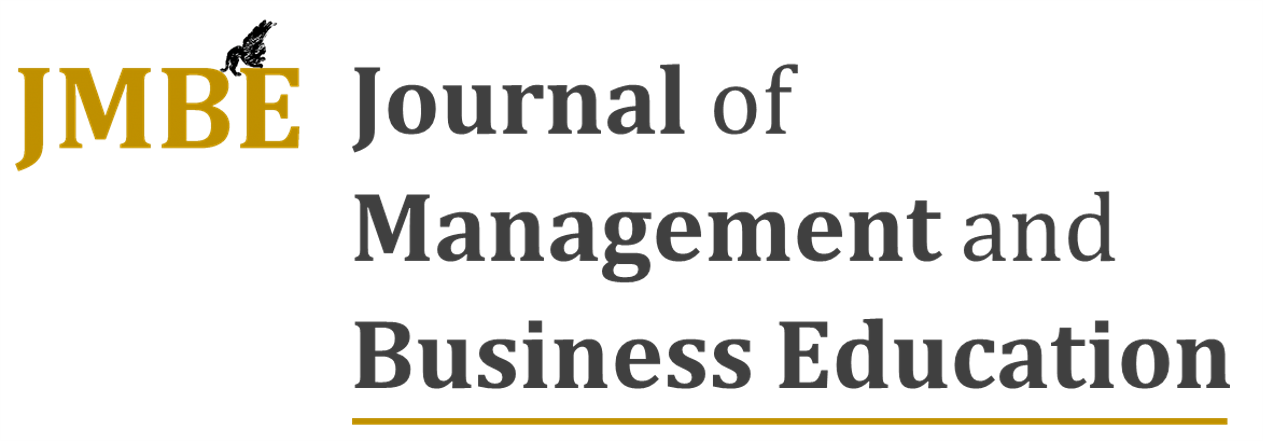Game of thrones in class (Episode 2). Improving gamification reduces amotivation and increases service quality in class?
DOI:
https://doi.org/10.35564/jmbe.2021.0010Keywords:
gamification, amotivation, service quality perception, teaching qualityAbstract
The present research is based on the work of Pelegrín-Borondo et al. (2020) which analyzed the results of a gamification developed in order to reduce the degree of students’ amotivation in the subjects and to increase the service quality perception in teaching. Not satisfied with the results obtained, a new gamification is developed in the following year introducing some improvements obtained from the participating students’ feedback. This research gathers the results of the new gamification with the same subjects and teachers. Once again, the results are contrary to the expected and very similar to those obtained by Pelegrín-Borondo et al. (2020), which indicates that not all types of gamification diminish amotivation, nor does it increase the perception of quality in teaching. This research could be considered as exploratory and the problem may come from the design of the gamification itself. Thus, the present research gives advice to improve the design of a gamification and provides discussion on recent research about guidelines for planning an appropriate gamification given the work context.
Downloads
References
Bartle, R. (1996). “Hearts, clubs, diamonds, spades: Players who suit MUDs”. Journal of MUD research, vol. 1 no. 1, pp. 1-19.
Bedoya Mejía, K. Y; Rodríguez González, M. S. L; Ramírez, S. (2015). “Relación entre la motivación académica y el rendimiento escolar de los estudiantes de bachillerato en extra-edad de un Colegio Colombiano”, Tecnológico de Monterrey.https://doi.org/10.35537/10915/59220
Bicen, H; Kocakoyun, S. (2018). “Perceptions of students for gamification approach: Kahoot as a case study”, International Journal of Emerging Technologies in Learning (iJET), Vol. 13, No. 02, pp. 72-93.https://doi.org/10.3991/ijet.v13i02.7467
Brunvand, S; Hill, D. (2019). “Gamifying your Teaching: Guidelines for Integrating Gameful Learning in the Classroom”, College Teaching, Vol. 67, No. 1, pp. 58-69.https://doi.org/10.1080/87567555.2018.1518893
de Sousa Borges, S; Durelli, V. H; Reis, H. M; Isotani, S. (2014, March). “A systematic mapping on gamification applied to education”. In Proceedings of the 29th Annual ACM Symposium on Applied Computing (pp. 216-222). ACM.https://doi.org/10.1145/2554850.2554956
Deterding, S., Sicart, M., Nacke, L., O'Hara, K. & Dixon, D. (2011). Gamification. Using game-design elements in non-gaming contexts. In CHI'11 extended abstracts on human factors in computing systems, 2425-2428, ACM.https://doi.org/10.1145/1979742.1979575
Dicheva, D; Dichev, C; Agre, G; Angelova, G. (2015). “Gamification in education: A systematic mapping study”, Journal of Educational Technology y Society, Vol. 18, No. 3, pp. 75-88.
González Menorca, C; Pelegrín Borondo, J. (2014). “Nuevas herramientas para la gestión de la calidad de servicio en el aula”. En Menorca, González Menorca, L. y Navaridas Nalda, F. (coord.). Acción pedagógica en los centros escolares: Enfoque teórico y práctico (pp. 117-134). Fundación Universidad de La Rioja: Logroño.https://doi.org/10.5176/2251-2349_hrmpd17.30
Hamari, J; Koivisto, J; Sarsa, H. (2014, January). “Does gamification work?--a literature review of empirical studies on gamification”. In 2014 47th Hawaii international conference on system sciences (HICSS) (pp. 3025-3034). IEEE.https://doi.org/10.1109/hicss.2014.377
Hunicke, R; LeBlanc, M; Zubek, R. (2004, July). “MDA: A formal approach to game design and game research”. In Proceedings of the AAAI Workshop on Challenges in Game AI, Vol. 4, No. 1, p. 1722.
Lee, J. J; Hammer, J. (2011). “Gamification in education: What, how, why bother?”, Academic Exchange Quarterly, Vol. 15, No. 2, pp. 146-151. Result score too low
Levin, R.I; Rubin, D. (1996). Estadística para administradores. Pretice Hall, Mexico.
Montgomery, S; Gregg, D. H; Somers, C. L; Pernice-Duca, F; Hoffman, A; y Beeghly, M. (2019). “Intrapersonal Variables Associated with Academic Adjustment in United States College Students”, Current Psychology, Vol. 38, No. 1, pp. 40-49.https://doi.org/10.1007/s12144-016-9533-0
Nah, F. F. H; Zeng, Q; Telaprolu, V. R; Ayyappa, A. P; Eschenbrenner, B. (2014, June). “Gamification of education: a review of literature. In International conference on HCI in business” (pp. 401-409). Springer, Cham.https://doi.org/10.1007/978-3-319-07293-7_39
Noyens, D; Donche, V; Coertjens, L; van Daal, T; Van Petegem, P. (2019). “The directional links between students’ academic motivation and social integration during the first year of higher education”, European Journal of Psychology of Education, Vol. 34, No. 1, pp. 67-86https://doi.org/10.1007/s10212-017-0365-6
Núñez, J. L; Martín-Albo, J; Navarro, J. G. (2005). Validación de la versión española de la Échelle de Motivation en Éducation. Psicothema, Vol. 17, No. 2, 344-349.
Parasuraman, A; Zeithaml, V. A; Berry, L. L. (1988). “Servqual: A multiple-item scale for measuring consumer perc”, Journal of Retailing, Vol. 64, No. 1, pp. 12-40.
Pelegrín-Borondo, J., Sierra-Murillo, Y., Olarte-Pascual, C. & García-Milon, A. (2020). Juego de tronos en el aula: Efecto de la gamificación en la amotivación y en la calidad percibida. Journal of Management and Business Education, Vol. 3, No. 1, pp. 72-89.https://doi.org/10.35564/jmbe.2020.0006
Potdevin, F; Vors, O; Huchez, A; Lamour, M; Davids, K; Schnitzler, C. (2018). “How can video feedback be used in physical education to support novice learning in gymnastics? Effects on motor learning, self-assessment and motivation”, Physical Education and Sport Pedagogy, Vol. 23, No. 6, pp. 559-574.https://doi.org/10.1080/17408989.2018.1485138
Real Academia Española (2021). Diccionario de la lengua española. Versión digital https://dle.rae.es/
Schell, J. (2008). The Art of Game Design: A book of lenses (1.a ed.). Morgan Kaufmann.
Stodnick, M; Rogers, P. (2008). “Using SERVQUAL to measure the quality of the classroom experience”, Decision Sciences Journal of Innovative Education, Vol. 6 No. 1, pp. 115-133.https://doi.org/10.1111/j.1540-4609.2007.00162.x
Vallerand, R. J; Fortier, M. S; Guay, F. (1997). “Self-determination and persistence in a real-life setting: toward a motivational model of high school dropout”, Journal of Personality and Social Psychology, Vol. 72, No. 5, pp. 1161. –1176.https://doi.org/10.1037/0022-3514.72.5.1161
Vallerand, R.J. (1997). “Toward a hierarchical model of intrinsic and extrinsic motivation”. En M. Zanna (Ed.): Advances in Experimental Social Psychology, Vol. 29, pp. 271-360. Toronto: Academic Press.https://doi.org/10.1016/s0065-2601(08)60019-2
Vallerand, R.J; Blais, M.R; Brière, N.M; Pelletier, L.G. (1989). “Construction et validation de l’Échelle de Motivation en Éducation (EME)”, Canadian Journal of Behavioral Sciences No. 21, pp. 323-349.https://doi.org/10.1037/h0079855
Verzosa, N., Greaves, S., Ellison, R., Ellison, A., & Davis, M. (2018). Eliciting preferences for ‘gamified’ travel surveys: a best-worst approach. Transportation Research Procedia, Vol. 32, pp. 211-223.https://doi.org/10.1016/j.trpro.2018.10.039
Volpi, V; Parente, G. A; Pifferi, G; Opromolla, A; Medaglia, C. M. (2018, July). “Improving Quality of Interaction with the Mobility Services Through the Gamification Approach”, In International Conference on Human-Computer Interaction (pp. 488-502). Springer, Cham.https://doi.org/10.1007/978-3-319-91250-9_38
Yuan, Y; Qi, K. K; Marcus, A. (2017, September). “Gamifying HPE Service Manager to Improve IT Service Desks' Knowledge Contribution”. In Proceedings of the 10th EAI International Conference on Simulation Tools and Techniques (pp. 141-148). ACM.https://doi.org/10.1145/3173519.3173536
Zeithaml, V. A. (1988). Consumer perceptions of price, quality, and value: a means-end model and synthesis of evidence”, Journal of Marketing, Vol. 52, No. 3, pp. 2-22.https://doi.org/10.1177/002224298805200302
Downloads
Published
How to Cite
Issue
Section
License
Copyright (c) 2023 Journal of Management and Business Education

This work is licensed under a Creative Commons Attribution-NonCommercial-ShareAlike 4.0 International License.
License terms at: https://creativecommons.org/licenses/by-nc/4.0/legalcode




